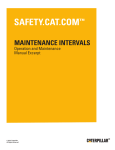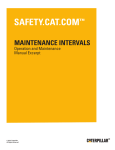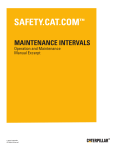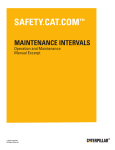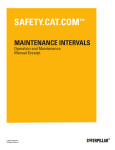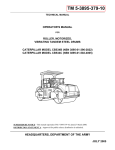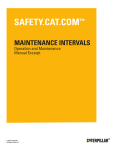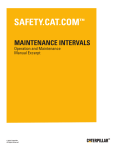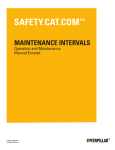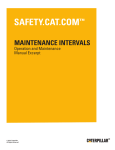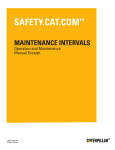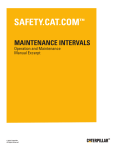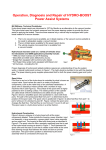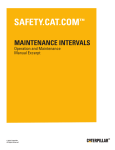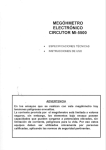Download MAINTENANCE INTERVALS - Safety
Transcript
MAINTENANCE INTERVALS Operation and Maintenance Manual Excerpt © 2010 Caterpillar All Rights Reserved ® ® SEBU8354-07 February 2012 Operation and Maintenance Manual 924H, 924HZ, 928HZ and 930H Wheel Loaders RCB1-Up (Machine) WLB1-Up (Machine) DHC1-Up (Machine) HXC1-Up (Machine) BYD1-Up (Machine) FTD1-Up (Machine) PED1-Up (Machine) CXK1-Up (Machine) JRL1-Up (Machine) JTM1-Up (Machine) KLN1-Up (Machine) RRS1-Up (Machine) JZZ1-Up (Machine) SAFETY.CAT.COM 148 Maintenance Section Maintenance Interval Schedule SEBU8354-07 i04784644 Maintenance Interval Schedule SMCS Code: 7000 184 185 191 192 Every 10 Service Hours or Daily Ensure that all safety information, warnings, and instructions are read and understood before any operation or any maintenance procedures are performed. The user is responsible for the performance of maintenance. All adjustments, the use of proper lubricants, fluids, filters, and the replacement of components due to normal wear and aging are included. Failure to adhere to proper maintenance intervals and procedures may result in diminished performance of the product and/or accelerated wear of components. Use mileage, fuel consumption, service hours, or calendar time, WHICH EVER OCCURS FIRST, in order to determine the maintenance intervals. Products that operate in severe operating conditions may require more frequent maintenance. Refer to the maintenance procedure for any other exceptions that may change the maintenance intervals. Note: The aftertreatment system can be expected to function properly for the useful life of the engine (emissions durability period), as defined by regulation. All prescribed maintenance requirements must be followed. Note: Before each consecutive interval is performed, all maintenance from the previous interval must be performed. Note: If Cat HYDO Advanced hydraulic oils are used, the hydraulic oil change interval is extended to 3000 hours. S·O·S services may extend the oil change even longer. Consult your Cat dealer for details. Backup Alarm - Test ............................................ Bucket Tips - Inspect/Replace ............................ Cooling System Coolant Level - Check .............. Engine Oil Level - Check .................................... Hydraulic System Oil Level - Check .................. Seat Belt - Inspect .............................................. Transmission Oil Level - Check .......................... Windows - Clean ................................................. 151 155 161 169 182 186 191 192 Every 50 Service Hours or Weekly Bucket Lower Pivot Bearings - Lubricate ............ 155 Cab Air Filter - Clean/Replace ............................ 158 Tire Inflation - Check ........................................... 188 Every 100 Service Hours or 2 Weeks Axle Oscillation Bearings - Lubricate .................. 150 Bucket Linkage and Loader Cylinder Bearings Lubricate ........................................................... 154 Steering Cylinder Bearings - Lubricate ............... 187 Every 250 Service Hours Cooling System Coolant Sample (Level 1) Obtain ............................................................... 162 Engine Oil Sample - Obtain ................................ 169 Every 250 Service Hours or Monthly Belts - Inspect/Replace ....................................... Brake Accumulator - Check ................................ Braking System - Test ......................................... Drive Shaft Spline (Center) - Lubricate ............... Drive Shaft Support Bearing - Lubricate ............. 152 152 153 164 165 Every 250 Service Hours or 3 Months When Required Battery or Battery Cable - Inspect/Replace ........ Bucket Cutting Edges - Inspect/Replace ............ Bucket Wear Plates - Inspect/Replace ............... Camera - Clean .................................................. Engine Air Filter Primary Element - Clean/ Replace ............................................................. Engine Air Filter Secondary Element - Replace .. Engine Air Precleaner - Clean ............................ Ether Starting Aid Cylinder - Replace ................. Fuel System - Prime ........................................... Fuel System Primary Filter (Water Separator) Drain ................................................................. Fuel Tank Cap and Strainer - Clean ................... Fuel Tank Water and Sediment - Drain ............... Fuses - Replace .................................................. Oil Filter - Inspect ................................................ Quick Coupler - Check ........................................ Radiator Core - Clean ......................................... Ride Control Accumulator - Check ..................... Window Washer Reservoir - Fill .......................... Window Wipers - Inspect/Replace ...................... 151 154 157 158 165 167 167 173 173 174 175 176 177 183 184 Steering Column Play - Check ............................ 187 Initial 500 Service Hours Engine Valve Lash - Check ................................. 173 Every 500 Service Hours Differential and Final Drive Oil Level - Check ..... Differential and Final Drive Oil Sample - Obtain .. Engine Crankcase Breather (Closed Circuit) Replace ............................................................. Hydraulic System Oil Sample - Obtain ............... Transmission Oil Sample - Obtain ...................... 163 164 168 183 191 Every 500 Service Hours or 3 Months Engine Oil and Filter - Change ........................... 170 SEBU8354-07 Fuel System Primary Filter (Water Separator) Element - Replace ............................................ 174 Fuel System Secondary Filter - Replace ............ 175 Transmission Oil Filter - Replace ........................ 190 Every 500 Service Hours or 1 Year Cooling System Coolant Sample (Level 2) Obtain ............................................................... 162 Every 1000 Service Hours Articulation Bearings - Lubricate ......................... 150 Engine Valve Lash - Check ................................. 173 Hydraulic System Oil Filter - Replace ................. 181 Every 1000 Service Hours or 6 Months Rollover Protective Structure (ROPS) - Inspect .. 185 Transmission Oil - Change ................................. 188 Every 2000 Service Hours or 1 Year Axle Oil Cooler Screen - Clean/Replace ............. 150 Differential and Final Drive Oil - Change ............ 163 Hydraulic Tank Breather - Replace ..................... 183 Every 3000 Service Hours Hydraulic System Oil - Change ........................... 178 Every 3 Years Seat Belt - Replace ............................................. 186 Every 6000 Service Hours Hydraulic System Oil - Change ........................... 178 Every 12 000 Service Hours or 6 Years Cooling System Coolant (ELC) - Change ........... 159 149 Maintenance Section Maintenance Interval Schedule 150 Maintenance Section Articulation Bearings - Lubricate SEBU8354-07 i01698389 Articulation Bearings Lubricate SMCS Code: 7057-086-BD; 7065-086-BD; 7066-086-BD Wipe the grease fittings before you lubricate the grease fittings. Illustration 119 g00916582 1. Make sure that there is no pressure in the lines for the axle oil. Loosen the fitting on the hose and drain the oil from the line into a suitable container. Dispose of the oil properly. 2. Remove the screen from the rear of the axle housing. Clean the screen in a clean, nonflammable solvent. Illustration 118 g00614530 Apply lubricant to one grease fitting on the upper pivot bearing (1). Apply lubricant to one grease fitting on the lower pivot bearing (2). i02154820 Axle Oil Cooler Screen Clean/Replace 3. Install the screen and the hose. 4. Check for leaks. Make any necessary repairs. i02814814 Axle Oscillation Bearings Lubricate SMCS Code: 3268-086-BD; 3278-086-BD SMCS Code: 1365-070-Z3; 1365-510-Z3 Reference: For information about containing fluid spillage, refer to Operation and Maintenance Manual, “General Hazard Information”. Clean the screens after any maintenance on the brake system. Illustration 120 924H and 924Hz g00614728 SEBU8354-07 Illustration 121 151 Maintenance Section Backup Alarm - Test g00904205 928Hz and 930H Apply grease to the remote grease fittings for the trunnion bearings. The grease fittings are located on the left side of the machine near the articulation joint. Illustration 122 i01698523 Backup Alarm - Test SMCS Code: 7406-081 g01416250 3. Turn the battery disconnect switch to the OFF position. Remove the battery disconnect switch key. Turn the engine start switch key to ON in order to perform the test. Apply the service brake. Move the transmission direction control lever to REVERSE position. The backup alarm should immediately sound. The backup alarm will continue to sound until the transmission direction control lever is moved to the NEUTRAL position or to the FORWARD position. The backup alarm is mounted in the back of the machine behind the rear grill. i04096831 Battery or Battery Cable Inspect/Replace SMCS Code: 1401-040; 1401-510; 1402-040; 1402-510 1. Turn the engine start switch to the OFF position. Turn all switches to the OFF position. 2. Open the engine access door on the right side of the machine. Illustration 123 g01416255 4. Remove the access panel for the battery on the right side and on the left side of the machine. NOTICE Do not allow the disconnected battery cable to contact the disconnect switch. 5. Disconnect the negative battery cable at the battery. 152 Maintenance Section Belts - Inspect/Replace SEBU8354-07 6. At the battery disconnect switch, disconnect the negative battery cable that is connected to the frame. 7. Perform the necessary repairs. Replace the cable or the battery, as needed. i02828865 Brake Accumulator - Check SMCS Code: 4263-535 8. Connect the battery cable at the battery disconnect switch, if equipped. If the machine is not equipped with a battery disconnect switch, connect the negative cable to the frame. 9. Connect the negative battery cable at the battery. Replace the battery cover. 10. Install the battery disconnect switch key. Turn the battery disconnect switch to the ON position. Recycle the Battery Illustration 124 Always recycle a battery. Never discard a battery. Always return used batteries to one of the following locations: • A battery supplier 1. Turn the engine start switch to the ON position. The alert indicator for brake oil pressure should come on if the braking system is not at normal operating pressure. 2. Start the engine. Run the engine at half speed for two minutes in order to increase the accumulator pressure. The alert indicator for brake oil pressure should go off. • An authorized battery collection facility • Recycling facility i02816216 Belts - Inspect/Replace SMCS Code: 1397-040; 1397-510 Serpentine Belt 1. Open the engine access door on the left side of the machine. 2. Inspect the condition of the serpentine belt. If the belt is worn or frayed, replace the belt. Note: The serpentine belt is the self-adjusting type. There is no adjustment of the tension. 3. Close the engine access door. g01411109 3. Stop the engine. Apply the service brake pedal and release the service brake pedal until the alert indicator for brake oil pressure comes on. This will decrease the accumulator pressure. A minimum of five applications of the service brake pedal are required. 4. If the alert indicator comes on after less than five applications of the brake, measure the accumulator precharge pressure. An authorized Caterpillar dealer can measure the nitrogen gas pressure in the accumulator. Use only dry nitrogen gas for recharging. SEBU8354-07 153 Maintenance Section Braking System - Test i00058445 Braking System - Test SMCS Code: 4251-081; 4267-081 Service Brake Holding Ability Test NOTICE If the machine moved while testing the brakes, contact your Caterpillar dealer. Have the dealer inspect and, if necessary, repair the service brake before returning the machine to operation. Refer to the Operations and Maintenance Manual, “Disk Brakes - Inspect” for the requirements of the disc thickness. Personal injury can result if the machine moves while testing. If the machine begins to move during test, reduce the engine speed immediately and engage the parking brake. Check the area around the machine. Make sure that the machine is clear of personnel and clear of obstacles. Make sure that the steering frame lock link is in the stored position. Test the brakes on a dry, level surface. Fasten the seat belt before you test the brakes. The following tests are used to determine if the service brake is functional. These tests are not intended to measure the maximum brake holding effort. The brake holding effort that is required to sustain a machine at a specific engine rpm varies depending on the machine. The variations are the differences in the engine setting, in the power train efficiency, and in the brake holding ability, etc. 1. Start the engine. Raise the bucket slightly. 2. Apply the service brake. Release the parking brake. 3. Press the top of the transmission neutralizer override switch. 4. Move the transmission control lever to THIRD SPEED FORWARD while the AUTO shift switch is in the OFF position. 5. Gradually increase the engine speed to high idle. The machine should not move. 6. Reduce the engine speed to low idle. Move the transmission to NEUTRAL. Engage the parking brake. Lower the blade to the ground. Stop the engine. Secondary Brake Holding Ability Test Check the area around the machine. Make sure that the machine is clear of personnel and clear of obstacles. Make sure that the steering frame lock link is in the stored position. Test the brakes on a dry, level surface. Fasten the seat belt before you test the brakes. The following tests are used to determine if the parking brake is functional. These tests are not intended to measure the maximum brake holding effort. The brake holding effort that is required to sustain a machine at a specific engine rpm varies depending on the machine. The variations are the differences in the engine setting, in the power train efficiency, and in the brake holding ability, etc. 1. Start the engine. Raise the bucket slightly. 2. Engage the parking brake. 3. Move the transmission control lever to THIRD SPEED FORWARD, to NEUTRAL, and back to THIRD SPEED FORWARD. This is done in order to override the transmission neutralizer for this test. Note: The parking brake indicator light should come on and the parking brake alarm should sound. 4. Gradually increase the engine speed to high idle. The machine should not move. If the machine begins to move, reduce the engine speed immediately and apply the service brake pedal. 5. Reduce the engine speed. Move the transmission to NEUTRAL. Lower the blade to the ground. Stop the engine. 154 Maintenance Section Bucket Cutting Edges - Inspect/Replace SEBU8354-07 i02814805 NOTICE If the machine moved while testing the brakes, contact your Caterpillar dealer. Bucket Linkage and Loader Cylinder Bearings - Lubricate Have the dealer inspect and, if necessary, repair the parking brakes before returning the machine to operation. SMCS Code: 5102-086-BD; 5104-086-BD; 6107-086-BD i01920076 Bucket Cutting Edges Inspect/Replace SMCS Code: 6801-040; 6801-510 Personal injury or death can result from bucket falling. Illustration 125 Block the bucket before changing bucket cutting edges. g00873076 Z-Bar 1. Raise the bucket. Place a block under the bucket. 2. Lower the bucket to the blocking. Do not block up the bucket too high. Block up the bucket so that the bucket is high enough to remove the cutting edges and the end bits. 3. Remove the bolts. Remove the cutting edge and the end bits. 4. Clean the contact surfaces. 5. Use the opposite side of the cutting edge, if this side is not worn. 6. Install a new cutting edge, if both edges are worn. 7. Install the bolts. Tighten the bolts to the specified torque. 8. Raise the bucket. Remove the blocks. 9. Lower the bucket to the ground. 10. After a few hours of operation, check the bolts for proper torque. Illustration 126 g00930756 VersaLink Grease fittings (1), (2), (3), and (4) are greased at the remote grease fitting on the left side of the front frame. Wipe off the fittings before you apply any lubricant. Apply lubricant to the grease fittings. The grease fittings are located on each side of the bucket and loader linkage. Note: The lower bucket pivot bearing needs to be greased at every 50 hour interval. SEBU8354-07 155 Maintenance Section Bucket Lower Pivot Bearings - Lubricate i02814823 Bucket Lower Pivot Bearings - Lubricate i03657242 Bucket Tips - Inspect/Replace SMCS Code: 6805-040; 6805-510 SMCS Code: 6101-086-BD; 6107-086-BD Personal injury or death can result from the bucket falling. Block the bucket before changing bucket tips. Bucket Tips Illustration 127 g00891053 Z-Bar Illustration 129 g00101352 (1) Usable (2) Replace the tip. (3) Replace the tip. Check the bucket tips for wear. If the bucket tip has a hole, replace the bucket tip. 1. Remove the pin from the bucket tip. The pin can be removed by one of the following methods. • Use a hammer and a punch from the retainer side of the bucket to drive out the pin. Illustration 128 g00891056 VersaLink Wipe off the fittings before you apply any lubricant. Apply lubricant to the grease fittings. The grease fittings are located on both sides of the bucket. • Use a Pin-Master. Follow Step 1.a through Step 1.c for the procedure. 156 Maintenance Section Bucket Tips - Inspect/Replace Illustration 130 SEBU8354-07 g00590670 (4) Back of Pin-Master (5) Extractor Illustration 132 g00101359 4. Install the new bucket tip onto the adapter. a. Place the Pin-Master on the bucket tooth. b. Align extractor (5) with the pin. c. Strike the Pin-Master at the back of the tool (4) and remove the pin. Note: The bucket tip can be rotated by 180 degrees in order to allow greater penetration or less penetration. 5. Drive the pin through the bucket tip. The pin can be installed by using one of the following methods: • From the other side of the retainer, drive the pin through the bucket tip, the adapter, and the retainer. • Use a Pin-Master. Follow Step 5.a through Step 5.e for the procedure. Note: To correctly install the pin into the retainer, the pin must be driven in from the right side of the tooth. Improper installation of the pin can result in the loss of the bucket tip. Illustration 131 g00590819 (6) Retainer (7) Retaining washer (8) Adapter 2. Clean the adapter and the pin. 3. Fit retainer (6) into retaining washer (7). Install this assembly into the groove that is in the side of adapter (8). Illustration 133 g00590666 (4) Back of Pin-Master (9) Pin setter (10) Pin holder a. Insert the pin through the bucket tooth. b. Place the Pin-Master over the bucket tooth and locate the pin in the hole of holder (10). SEBU8354-07 157 Maintenance Section Bucket Wear Plates - Inspect/Replace c. Strike the tool with a hammer at the back of the tool (4) in order to start the pin. d. Slide pin holder (10) away from the pin and rotate the tool slightly in order to align pin setter (9) with the pin. e. Strike the end of the tool until the pin is fully inserted. 4. Clean adapter (6). Installation 1. Clean the adapter and the area around the latch, if necessary. 2. Install the new bucket tip onto the adapter with a slight clockwise rotation. 6. After you drive the pin, make sure that the retainer fits snugly into the pin groove. K-Series Tip Removal Illustration 136 g01124736 3. Install the retainer. Make sure that the retainer's latch catches under the tip pocket. 4. Make sure that the latch is properly seated by trying to remove the bucket tip. Illustration 134 g01389463 Note: Retainers are often damaged during the removal process. Caterpillar recommends the installation of a new retainer when bucket tips are rotated or replaced. i02003771 Bucket Wear Plates Inspect/Replace SMCS Code: 6120-040; 6120-510 Personal injury or death can result from falling bucket. When working under or around the bucket or linkage, with the bucket raised, proper support must be provided for the bucket and/or the linkage. Replace the wear plates before damage to the bottom of the bucket occurs. Illustration 135 g01175361 1. Use a pry bar in order to disengage retainer (5). 2. Use the pry bar in order to remove retainer (5) from bucket tip (4). 3. Remove bucket tip (4) from adapter (6) with a slight counterclockwise rotation. 1. Raise the bucket and block up the bucket. 2. Loosen bolts and remove wear plates. 3. Install new wear plates. Tighten the bolts to the specified torque. 158 Maintenance Section Cab Air Filter - Clean/Replace SEBU8354-07 Reference: For more information, refer to Specifications, SENR3130, “Torque Specifications”. i01699420 Cab Air Filter - Clean/Replace SMCS Code: 7342-070; 7342-510 Clean Filters Note: Clean the filter elements more often in dusty conditions. If there is a noticeable reduction in the airflow from the air vents, check the filter elements. Illustration 138 g00447093 5. Remove the filter cover and filter elements. The filter elements are located near the left side of the operator seat. Note: Raise the operator seat in order to remove the filter elements. 6. Clean the filter elements with compressed air. You can also wash the filter elements with a solution of warm water and of a nonsudsing household detergent. Illustration 137 g00614999 1. Remove the filter cover. The filter cover is located on the left side of the operator compartment under the steps. 2. Remove the filter elements. Clean the filter elements with compressed air. You can also wash the filter elements with a solution of warm water and of a nonsudsing household detergent. Do not wash the filter elements while the filter elements are installed on the machine. 3. Rinse the filter elements in clean water. Air dry the filter elements thoroughly. 4. Install the filter elements and replace the cover. 7. Rinse the filter elements in clean water. Air dry the filter elements thoroughly. 8. Replace any filter elements that are worn or damaged. 9. Face the seal toward the parking brake lever when you install the filter element. i02816405 Camera - Clean (If Equipped) SMCS Code: 7348-070 In order to maintain sufficient vision, keep the Work Area Vision System (WAVS) camera lens and the display clean. SEBU8354-07 159 Maintenance Section Cooling System Coolant (ELC) - Change Display i03739601 Cooling System Coolant (ELC) - Change SMCS Code: 1350-044-NL Pressurized system: Hot coolant can cause serious burn. To open cap, stop engine, wait until radiator is cool. Then loosen cap slowly to relieve the pressure. Illustration 139 g01223034 WAVS display Use a soft, damp cloth in order to clean the display. The display has a soft plastic surface that can be easily damaged by an abrasive material. The display is not sealed. Do not immerse the display with liquid. Camera NOTICE Mixing ELC with other products will reduce the effectiveness of the coolant. This could result in damage to cooling system components. If Caterpillar products are not available and commercial products must be used, make sure they have passed the Caterpillar EC-1 specification for pre-mixed or concentrate coolants and Caterpillar Extender. Note: This machine is shipped with Extended Life Coolant. Extended Life Coolant is recommended for use. Drain the coolant whenever the coolant is dirty. Drain the coolant whenever the coolant starts to foam. Illustration 140 g01223051 The WAVS camera is located on the rear of the machine in the center of the fan guard. Use a damp cloth or water spray in order to clean the camera lens. The camera is a sealed unit. The camera is not affected by high pressure spray. The camera is equipped with an internal heater to help counteract the effects of condensation, snow, or ice. Note: For more information on WAVS, refer to Operation and Maintenance Manual, SEBU8157, “Work Area Vision System”. Illustration 141 g01416397 160 Maintenance Section Cooling System Coolant (ELC) - Change SEBU8354-07 The overflow tank is located under the access panel on the top of the engine compartment. Use the steps and the handholds on the right side of the machine in order to reach the access panel. 1. Open the access panel on the top of the engine compartment. 2. Slowly lift the tab on the cap for the overflow tank in order to relieve system pressure. Remove the cap for the overflow tank. 7. While the engine is stopped, flush the system with water. Flush the system until the draining water is transparent. 8. Close the drain valve. 9. Add the coolant solution. See the following topics: • Operation and Maintenance Manual, “Cooling System Specifications” • Operation and Maintenance Manual, “Refill Capacities” Note: If you are using Caterpillar antifreeze, do not add the supplemental coolant additive at this time. 10. Start the engine. Run the engine without the cap for the overflow tank until the thermostat opens and the coolant level stabilizes. Illustration 142 g00921567 3. Open the access doors on both sides of the engine compartment. Remove five bolts (1). Remove plate (2). Illustration 144 g01416399 11. Maintain the coolant level between the ADD and FULL marks on the overflow tank. Illustration 143 g00921568 4. The drain valve is located on the bottom left corner of the radiator. Open the drain valve. Allow the coolant to drain into a suitable container. 5. Close the drain valve. Fill the system with a solution which consists of clean water and of cooling system cleaner. The concentration of the cooling system cleaner in the solution should be between 6 percent and 10 percent. 6. Start the engine. Run the engine for 90 minutes. Stop the engine. Drain the cleaning solution into a suitable container. 12. Install the cap for the overflow tank. 13. Stop the engine. 14. Replace the access panel. Close the access door. SEBU8354-07 161 Maintenance Section Cooling System Coolant Level - Check Flushing the Extended Life Coolant From the Cooling System Some engines utilize Extended Life Coolant. See the Operation and Maintenance Manual, “Maintenance Interval Schedule” in order to determine the service interval. If a Extended Life Coolant was previously used, flush the cooling system with clean water. No other cleaning agents are required. Flushing a Standard Coolant From the Cooling System If you change the coolant of a machine to Extended Life Coolant from another type of coolant, use a Caterpillar cleaning agent to flush the cooling system. After you drain the cooling system, thoroughly flush the cooling system with clean water. All of the cleaning agent must be removed from the cooling system. Illustration 145 i02839787 Cooling System Coolant Level - Check SMCS Code: 1350-535-FLV g01416399 2. Maintain the coolant level between the ADD and the FULL marks on the overflow tank when the cooling system is cool. Note: Refer to Operation and Maintenance Manual, “General Hazard Information” for information on containing fluid spillage. Pressurized system: Hot coolant can cause serious burn. To open cap, stop engine, wait until radiator is cool. Then loosen cap slowly to relieve the pressure. NOTICE Excessive additive (greater than the recommended 6% initial fill) together with concentrations of antifreeze greater than 60% cause deposits to form and can result in radiator tube blockage and overheating. 1. Open the engine access panel on the right side of the machine. Illustration 146 g01416397 3. Open the access panel on the top of the engine compartment. 4. If additional coolant is necessary, remove the cap on the overflow tank and add the appropriate coolant mixture. If you need to add coolant daily, check the cooling system for leaks. 162 Maintenance Section Cooling System Coolant Sample (Level 1) - Obtain 5. Install the cap for the overflow tank. Close the cover on top of the engine compartment. 6. Close the engine compartment. • Place the sample in the mailing tube immediately after obtaining the sample in order to avoid contamination. • Never collect samples from expansion bottles. i02161416 Cooling System Coolant Sample (Level 1) - Obtain SMCS Code: 1350-008; 1395-008; 7542 NOTICE Care must be taken to ensure that fluids are contained during performance of inspection, maintenance, testing, adjusting and repair of the product. Be prepared to collect the fluid with suitable containers before opening any compartment or disassembling any component containing fluids. Refer to Special Publication, NENG2500, “Caterpillar Tools and Shop Products Guide” for tools and supplies suitable to collect and contain fluids on Caterpillar products. Dispose of all fluids according to local regulations and mandates. Note: Level 1 results may indicate a need for Level 2 Analysis. Reference: See Operation and Maintenance Manual, “Cooling System Level - Check” in order to access the overflow tank for coolant sample. Obtain the sample of the coolant as close as possible to the recommended sampling interval. In order to receive the full effect of S·O·S analysis, you must establish a consistent trend of data. In order to establish a pertinent history of data, perform consistent samplings that are evenly spaced. Supplies for collecting samples can be obtained from your Caterpillar dealer. Use the following guidelines for proper sampling of the coolant: • Complete the information on the label for the sampling bottle before you begin to take the samples. • Keep the unused sampling bottles stored in plastic bags. • Obtain coolant samples directly from the coolant sample port. You should not obtain the samples from any other location. • Keep the lids on empty sampling bottles until you are ready to collect the sample. SEBU8354-07 • Never collect samples from the drain for a system. Submit the sample for Level 1 analysis. Level 1 analysis is a test of the properties of the coolant. For additional information about coolant analysis, see Special Publication, SEBU6250, “Caterpillar Machine Fluids Recommendations” or consult your Caterpillar dealer. i02161468 Cooling System Coolant Sample (Level 2) - Obtain SMCS Code: 1350-008; 1395-008; 7542 NOTICE Care must be taken to ensure that fluids are contained during performance of inspection, maintenance, testing, adjusting and repair of the product. Be prepared to collect the fluid with suitable containers before opening any compartment or disassembling any component containing fluids. Refer to Special Publication, NENG2500, “Caterpillar Tools and Shop Products Guide” for tools and supplies suitable to collect and contain fluids on Caterpillar products. Dispose of all fluids according to local regulations and mandates. Reference: See Operation and Maintenance Manual, “Cooling System Level - Check” in order to access the overflow tank for coolant sample. Obtain the sample of the coolant as close as possible to the recommended sampling interval. Supplies for collecting samples can be obtained from your Caterpillar dealer. Refer to Operation and Maintenance Manual, “Cooling System Coolant Sample (Level 1) - Obtain” for the guidelines for proper sampling of the coolant. Submit the sample for Level 2 analysis. The Level 2 analysis is a comprehensive chemical evaluation of the coolant. This analysis is also a check of the overall condition of the inside of the cooling system. SEBU8354-07 163 Maintenance Section Differential and Final Drive Oil - Change Reference: For additional information about coolant analysis, refer to Special Publication, SEBU6250, “Caterpillar Machine Fluids Recommendations” or consult your Caterpillar dealer. i03024515 Differential and Final Drive Oil - Change SMCS Code: 3278-044; 4011-044 Wipe the covers and surfaces around openings before you check the oil. Wipe the covers and surfaces around openings before you add oil. Illustration 149 g00615872 3. Remove the dipstick/fill plug for the front differential and remove the dipstick/fill plug for the rear differential. 4. Add 0.5 L (.53 qt) of Hydraulic Oil Additive to each axle. 5. Fill the axles with oil. Maintain the oil between the “ADD” mark and the “FULL” mark on the dipstick/fill plug of each differential. See Operation and Maintenance Manual, “Lubricant Viscosities” and Operation and Maintenance Manual, “Refill Capacities”. Illustration 147 g00615911 Note: Install the dipstick/fill plug completely before you check the oil level. If the dipstick/fill plug is not installed completely, an incorrect oil level reading can occur. 6. Replace the dipstick/fill plugs for each differential. Operate the machine for a few minutes and allow the oil to flow completely through the axles. Remove the dipstick/fill plugs and recheck the oil level. Add oil, if necessary. 7. Clean the dipstick/fill plugs and install the dipstick/fill plugs for each differential. i02310335 Illustration 148 g00615871 1. Remove the drain plugs for the front differential (1) and for the rear differential (2). Allow the oil to drain into a suitable container. 2. Clean the drain plugs and install the drain plugs. Differential and Final Drive Oil Level - Check SMCS Code: 3278-535-FLV; 4011-535-FLV Before you measure the oil level, operate the machine for a few minutes. This will allow all of the oil to reach a common level. Park the machine on level ground. Lower the bucket and apply slight downward pressure. Engage the parking brake. Stop the engine. 164 Maintenance Section Differential and Final Drive Oil Sample - Obtain SEBU8354-07 i02091494 Differential and Final Drive Oil Sample - Obtain SMCS Code: 3278-008; 4011-008; 4070-008; 7542 Illustration 150 g00615872 NOTICE Always use a designated pump for oil sampling, and use a separate designated pump for coolant sampling. Using the same pump for both types of samples may contaminate the samples that are being drawn. This contaminate may cause a false analysis and an incorrect interpretation that could lead to concerns by both dealers and customers. 1. Remove the dipstick/fill plug for the front differential. Check the oil level. 2. Maintain the oil level between the “ADD” mark and the “FULL” mark on the dipstick/fill plug. Add oil, if necessary. Replace the dipstick/fill plug. Illustration 152 g00614039 In order to obtain a sample of the differential and final drive oil, remove the filler plug. Withdraw the oil through the filler opening. Illustration 151 g00615943 3. Remove the dipstick/fill plug for the rear differential. Check the oil level. 4. Maintain the oil level between the “ADD” mark and the “FULL” mark on the dipstick/fill plug. Add oil, if necessary. Replace the dipstick/fill plug. Refer to Special Publication, SEBU6250, “Caterpillar Machine Fluids Recommendations”, “S·O·S Oil Analysis” for information that pertains to obtaining an oil sample. Refer to Special Publication, PEHP6001, “How To Take A Good Oil Sample” for more information about obtaining an oil sample. i01700983 Drive Shaft Spline (Center) Lubricate SMCS Code: 3253-086-SN Wipe the grease fitting before you lubricate the grease fitting. NOTICE To prevent damage to the seal, fully articulate the machine to the right or to the left, before lubricating the spline. SEBU8354-07 165 Maintenance Section Drive Shaft Support Bearing - Lubricate 1. Start the engine. Raise the bucket. Release the parking brake. Fully articulate the machine to the left or to the right. 2. Lower the bucket to the ground. Engage the parking brake. Stop the engine. Illustration 155 g00909201 924H and 924Hz Illustration 153 g00616221 3. Apply lubricant to the grease fitting that is on the drive shaft spline. 4. Start the engine. Raise the bucket. Release the parking brake. Articulate the machine until the machine is straight. 5. Lower the bucket until the bucket exerts a slight downward pressure on the ground. Stop the engine. Engage the parking brake. Illustration 156 g00616286 928Hz and 930H i02814810 Drive Shaft Support Bearing Lubricate SMCS Code: 3267-086-BD Wipe the grease fitting before you lubricate the grease fitting. Apply lubricant to the grease fitting that is on the drive shaft support bearing. i04662871 Engine Air Filter Primary Element - Clean/Replace SMCS Code: 1054-070-PY; 1054-510-PY The primary air filter element is located in the engine compartment. NOTICE Never service the air cleaner when the engine is running, to avoid engine damage. Illustration 154 g00616283 166 Maintenance Section Engine Air Filter Primary Element - Clean/Replace NOTICE Caterpillar recommends certified air filter cleaning services that are available at Cat dealers. The Cat cleaning process uses proven procedures to assure consistent quality and sufficient filter life. Observe the following guidelines if you attempt to clean the filter element: Do not tap or strike the filter element in order to remove dust. SEBU8354-07 Note: Replace the primary element after the primary element has been cleaned six times. Also replace the primary element if the primary element has been in service for 1 year. 3. Install a clean filter element and install the cover. Alternator Guard and Filter (If Equipped) If your machine is equipped with the heavy-duty alternator, perform the following procedure. Do not wash the filter element. Use low pressure compressed air in order to remove the dust from the filter element. Air pressure must not exceed 207 kPa (30 psi). Direct the air flow up the pleats and down the pleats from the inside of the filter element. Take extreme care in order to avoid damage to the pleats. Do not use air filters with damaged pleats, gaskets, or seals. Dirt entering the engine will cause damage to engine components. Service the air cleaner filter element when the indicator light comes on. Refer to Operation and Maintenance Manual, “Alert Indicators” for information about the alert indicator. Illustration 158 Illustration 157 g00101864 1. Remove the air cleaner housing cover (1). 2. Remove the primary filter element (2) from the air cleaner housing. When you use pressure air, the maximum air pressure is 207 kPa (30 psi). a. When you clean the inside pleats and the outside pleats, direct the air along the pleats. b. Inspect the filter elements after you clean the filter elements. Do not use a filter if the pleats, the gaskets, or the seals are damaged. g02346203 At the same time that the primary filter element is cleaned, check and clean the alternator filter. Visibly inspect cover and filter to determine if excessive debris buildup has occurred. Remove the three fasteners holding the cover to the alternator. Remove the filter and clean or replace as needed. Clean debris buildup from the cover. Insert the filter and install the cover and filter with the original fasteners. Torque the bolts to 2.5 ± 0.5 N·m (1.8 ± 0.4 lb ft). Note: If the turbo hose is removed, keep the area clean. Ensure that all hoses and clamps are properly installed before operating the engine. SEBU8354-07 167 Maintenance Section Engine Air Filter Secondary Element - Replace i02839331 Engine Air Filter Secondary Element - Replace SMCS Code: 1054-510-SE NOTICE Always replace the secondary filter element. Never attempt to reuse the secondary filter element by cleaning the element. When the primary filter element is replaced, the secondary filter element should be replaced. The secondary filter element should also be replaced if the restricted Air Filter indicator comes on after the installation of a clean primary filter element or if the exhaust smoke is still black. 1. Open the engine access door on the right side of the machine. Illustration 161 g00101865 5. Cover the air inlet opening. Clean the inside of the air cleaner housing. 6. Inspect the gasket between the air inlet pipe and the air cleaner housing. Replace the gasket if the gasket is damaged. 7. Uncover the air inlet opening. Install a new secondary element. 8. Install the primary element and the air cleaner housing cover. Fasten the clips in order to secure the air cleaner housing cover. 9. Close the engine access door. i03001668 Illustration 159 g00101864 Engine Air Precleaner - Clean (If Equipped) SMCS Code: 1055-070 2. Remove the air cleaner housing cover (1). 3. Remove the primary filter element (2) from the air cleaner housing. Illustration 160 4. Remove the secondary filter element. g00038606 Illustration 162 g01521423 168 Maintenance Section Engine Crankcase Breather (Closed Circuit) - Replace Use the ladder and the platform in order to access the precleaner bowl. The ladder and the platform are located on the right side of the machine. 1. Empty the precleaner bowl whenever the dirt reaches the “FULL” mark. Illustration 163 g01521425 SEBU8354-07 i04571790 Engine Crankcase Breather (Closed Circuit) - Replace SMCS Code: 1317-510-FQ Illustration 164 g01300560 Illustration 165 g00927676 2. Loosen the wing nut on the cover and remove the cover. 3. Empty the precleaner bowl. Wash the precleaner bowl and wash the cover. 4. Install the precleaner bowl and install the cover. Tighten the wing nut until the wing nut is only finger tight. Do not use a tool to tighten the wing nut. (1) (2) (3) (4) (5) Breather Cap O-Ring O-Ring for the Breather Element Breather Element Housing for the Breather 1. Open the engine access door that is located on the right side of the machine. SEBU8354-07 169 Maintenance Section Engine Oil Level - Check 2. Turn the cover (1) for the filter housing counterclockwise for one quarter of a turn in order to remove the cover. 2. While the engine is stopped, maintain the oil level in the crosshatched region of the engine oil dipstick (1). 3. Remove the filter element (4) by pulling the filter element out of the housing (5). 3. If necessary, remove the oil filler plug and add oil. 4. Clean the inside of the housing for the breather (5). 5. Lubricate the O-ring (3) with clean engine oil. If necessary, fit a new O-ring (3) to the housing for the breather. 6. Install a new filter element (4). 4. Clean the oil filler plug and install the oil filler plug. 5. Close the engine access door. i02979423 Engine Oil Sample - Obtain SMCS Code: 1348-008; 7542 7. Install the cover (1) for the filter housing and turn one quarter of a turn clockwise in order to lock the cover in place. 8. Close all access covers. i02830922 Engine Oil Level - Check SMCS Code: 1000-535-FLV NOTICE Do not overfill the crankcase. Engine damage can result. 1. Open the engine access door on the right side of the machine. Illustration 167 g01507256 Oil Sample Port Use the sampling valve in order to obtain a sample of the engine oil. The engine must be running in order to take a sample of the engine oil. Refer to Special Publication, SEBU6250, “Caterpillar Machine Fluids Recommendations”, “S·O·S Oil Analysis” for information that pertains to obtaining an oil sample. Refer to Special Publication, PEHP6001, “How To Take A Good Oil Sample” for more information about obtaining an oil sample. Illustration 166 (1) (2) (3) (4) Oil Filler Cap Dipstick Oil Filter Oil Separator Filter g01412248 170 Maintenance Section Engine Oil and Filter - Change SEBU8354-07 i03878977 • Shorten the oil change interval to 250 hours. Engine Oil and Filter - Change • Proceed to Program B. SMCS Code: 1318-510 • Change to a preferred oil type in the “Lubricant Selection of the Oil Change Interval NOTICE A 500 hour engine oil change interval is available, provided that the operating conditions and recommended multigrade oil types are met. When these requirements are not met, shorten the oil change interval to 250 hours, or use an S·O·S Services oil sampling and analysis program to determine an acceptable oil change interval. If you select an interval for oil and filter change that is too long, you may damage the engine. The normal engine oil change interval is listed in this Operation and Maintenance Manual, “Maintenance Interval Schedule”. Abnormally harsh operating cycles or harsh environments can shorten the service life of the engine oil. Arctic temperatures, corrosive environments, or extremely dusty conditions may require a reduction in engine oil change intervals. Also refer to Special Publication, SEBU5898, “Cold Weather Recommendations for All Caterpillar Machines”. Poor maintenance of air filters or of fuel filters requires reduced oil change intervals. Consult your Caterpillar dealer for more information if this product will experience abnormally harsh operating cycles or harsh environments. Adjustment of the Oil Change Interval Note: Your Caterpillar dealer has additional information on these programs. Cat oil filters are recommended. Program A Verification for an Oil Change Interval of 500 Hours This program consists of three oil change intervals of 500 hours. Oil sampling and analysis is done at 250 hours and 500 hours for each of the three intervals for a total of six oil samples. The analysis includes oil viscosity and infrared (IR) analysis of the oil. If all of the results are satisfactory, the 500 hour oil change interval is acceptable for the machine in that application. Repeat Program A if you change the application of the machine. If a sample does not pass the oil analysis, take one of these actions: Viscosities for Ambient Temperatures” Table in this Operation and Maintenance Manual Program B Optimizing Oil Change Intervals Begin with a 250 hour oil change interval. The oil change intervals are adjusted by increments. Each increment is an additional 50 hours. Periodic oil sampling and analysis is done during each interval. The analysis includes oil viscosity and infrared (IR) analysis of the oil. Repeat Program B if you change the application of the machine. If an oil sample does not pass the analysis, shorten the oil change interval, or change to a preferred multigrade oil type in the listing above. References Reference: Special Publication, SEBU6250, “Caterpillar Machine Fluids Recommendations” Reference: Special Publication, SEBU5898, “Cold Weather Recommendations for All Caterpillar Machines” Reference: Special Publication, PEDP7035, “Optimizing Oil Change Intervals” Reference: Special Publication, PEDP7036, “S·O·S Fluid Analysis” Reference: Special Publication, PEDP7076, “Understanding the S·O·S Oil Analysis Tests” SEBU8354-07 171 Maintenance Section Engine Oil and Filter - Change Drain the Oil Method with Drain Hoses (If Equipped) Illustration 168 g01507438 (8) Bolts (9) Access Panel for the Oil Drain Valve Illustration 169 (1) (2) (3) (4) (5) (6) (7) g01506895 Oil Filler Cap Dipstick Oil Filter Oil Separator Filter Drain Valve on the Oil Filter Oil Drain Valve Plugs The crankcase drain is on the right side of the oil pan. 1. Open the engine access door on the right side of the machine. 2. Loosen the two bolts on the access panel for the oil drain valve on the right side of the machine. 3. Swing the access panel open. 4. Remove the plastic plug in the bottom of the drain hose for the crankcase. 5. Remove the plastic plug in the bottom of the hose for the drain for the oil filter. 6. Place the ends of the hoses into a suitable container. 7. Open the crankcase drain. 8. Open the drain on the oil filter base. 9. Allow the oil to drain completely from the engine. 10. Close the crankcase drain. 172 Maintenance Section Engine Oil and Filter - Change SEBU8354-07 11. Swing the access panel back into the closed position. 12. Tighten the bolts on the access panel. 13. Close the drain on the oil filter base. 14. Install the plugs in each hose. Method Without Drain Hoses Illustration 171 (1) (2) (3) (4) g01412248 Oil Filler Cap Dipstick Oil Filter Oil Separator Filter 2. Remove the filter element with a strap type wrench. Refer to Operation and Maintenance Manual, “Oil Filter - Inspect”. Illustration 170 g01412276 The crankcase drain is on the right side of the oil pan. 1. Open the crankcase drain and drain the oil into a suitable container. Install the plug into the oil pan. Install New Filters 1. Open the access door on the right side of the machine. 3. Clean the filter mounting base with a clean cloth. Make sure that the old filter gasket has been removed. Note: Cat filters are designed to ensure a ready supply of oil with every engine start. Use of approved Cat filters is recommended on this machine. 4. Apply a thin film of clean engine oil to the sealing surface of the new filter element. 5. Install a new engine oil filter hand tight until the seal of the engine oil filter contacts the base. Note the position of the index marks on the filter in relation to a fixed point on the filter base. Note: There are rotation index marks on the engine oil filter that are spaced 90 degrees or 1/4 of a turn away from each other. When you tighten the engine oil filter, use the rotation index marks as a guide. 6. Tighten the filter according to the instructions that are printed on the filter. Use the index marks as a guide. For non-Caterpillar filters, use the instructions that are provided with the filter. Note: You may need to use a Cat strap wrench, or another suitable tool, in order to turn the filter to the amount that is required for final installation. Make sure that the installation tool does not damage the filter. SEBU8354-07 173 Maintenance Section Engine Valve Lash - Check Oil Separator Filter (Crankcase Breather) Use the same procedure in order to replace the Oil Separator Filter. This filter must be replaced at the same time as the engine oil filter. i02830514 Ether Starting Aid Cylinder Replace (If Equipped) SMCS Code: 1456-510-CD Fill with Oil 1. Remove the oil filler plug. Fill the crankcase with new oil. See Operation and Maintenance Manual, “Lubricant Viscosities” and Operation and Maintenance Manual, “Refill Capacities”. Clean the oil filler plug and install the oil filler plug. 2. Start the engine and allow the oil to warm. Check for leaks. 3. Stop the engine and allow the oil to drain back into the oil pan. Maintain the oil level in the crosshatched region of the engine oil dipstick. Add oil, if necessary. 4. Close the engine access doors. i03854660 Engine Valve Lash - Check SMCS Code: 1105-535 Refer to the Service Manual for the complete adjustment procedure for the engine valve lash. A qualified mechanic should adjust the engine valve lash because special tools and training are required. Illustration 172 g00101192 1. Open the engine hood on the right side. The ether starting aid cylinder is mounted on the frame of the machine next to the air cleaner. 2. Loosen retaining clamp (1) and unscrew ether starting aid cylinder (2). 3. Remove the gasket. Install the new gasket that is provided with each new ether starting aid cylinder. 4. Install new ether starting aid cylinder (2) hand tight. Tighten retaining clamp (1) securely. 5. Close the engine hood. i04422151 Fuel System - Prime SMCS Code: 1250-548 This machine is equipped with a fuel transfer pump that is electric. Two examples that may cause the fuel system to lose prime are listed here: • The machine runs out of fuel. • The Fuel System Filter/Water Separator Element is replaced. Follow the steps below in order to prime the fuel system. 1. Ensure that the battery disconnect switch is in the ON position. 174 Maintenance Section Fuel System Primary Filter (Water Separator) - Drain SEBU8354-07 2. The primary fuel filter is located in the right side of the machine by the radiator. Examine the clear bowl. 1. Loosen the drain valve on the bottom of the water separator. Allow the water and the sediment to drain into a suitable container. 3. The bowl must be full of fuel. If the bowl is not full of fuel, use the switch on the filter base to turn on the pump. Run the pump until the clear bowl is full of fuel. 2. Tighten the drain valve. 4. Attempt to start the engine. If the engine starts and the engine runs rough or the engine misfires, operate the engine at low idle until the engine runs smoothly. 4. Tighten the drain valve and close the engine access door. Note: If the engine fails to start or if the engine continues to misfire or smoke, stop the engine and repeat the procedure. If the problem persists after repeating the procedure, consult your Cat dealer. Fuel System Primary Filter (Water Separator) Element Replace i02833831 Fuel System Primary Filter (Water Separator) - Drain SMCS Code: 1263-543 The water separator is located in the engine compartment on the right side of the machine. Note: This unit has a dual purpose. The element serves as a water separator and a fuel filter. 3. If the engine fails to start, change the fuel filter. If there is a power loss, change the fuel filter. i02833815 SMCS Code: 1260-510; 1263-510-FQ NOTICE Do not fill fuel filters with fuel before installing them. The fuel will not be filtered and could be contaminated. Contaminated fuel will cause accelerated wear to fuel system parts. The fuel system should be primed prior to starting the engine. Note: This unit has a dual purpose. The element serves as a water separator and a fuel filter. The water separator element is located in the engine compartment on the right side of the machine. Illustration 173 (1) (2) (3) (4) Primary Fuel Filter Water Separator Drain Secondary Fuel Filter g01413118 Illustration 174 (1) (2) (3) (4) Primary Fuel Filter Water Separator Drain Secondary Fuel Filter g01413118 SEBU8354-07 175 Maintenance Section Fuel System Secondary Filter - Replace 1. Open the drain on the water separator bowl. Allow the water and fuel to drain into a suitable container. 2. Support the water separator element and rotate the locking ring counterclockwise. Remove the locking ring. 3. While the water separator bowl is attached, remove the water separator element from the mounting base. 4. Remove the water separator bowl from the filter element. Clean the water separator bowl and clean the O-ring groove. Note: The water separator bowl is reusable. Do not discard the water separator bowl. 5. Inspect the O-ring seal of the water separator bowl for damage. Replace the O-ring seal, if necessary. 6. Lubricate the O-ring seal with clean diesel fuel or lubricate the O-ring seal with motor oil. Place the O-ring seal in the groove in the water separator bowl. 7. Spin the water separator bowl onto the new filter element by hand until the filter element is snug. Do not use tools to tighten the filter element. 8. Install the new water separator element. Rotate the locking ring clockwise in order to fasten the filter to the mounting base. 9. Prime the fuel system in order to fill the water separator element with fuel. Refer to Operation and Maintenance Manual, “Fuel System - Prime”. i02833836 Fuel System Secondary Filter Replace SMCS Code: 1261-510-SE NOTICE Do not fill fuel filters with fuel before installing them. Contaminated fuel will cause accelerated wear to fuel system parts. The fuel filter is located in the engine compartment on the right side of the machine. 1. Open the engine access door on the right side of the machine. Illustration 175 (1) (2) (3) (4) g01413118 Primary Fuel Filter Water Separator Drain Secondary Fuel Filter 2. Remove the fuel filter. Inspect the fuel filter for debris by cutting the filter open. Discard the filter properly. 3. Clean the mounting base of the fuel filter. Remove any part of the old seal that remains on the mounting base of the fuel filter. 4. Coat the seal of the new fuel filter with clean diesel fuel. 5. Install the new fuel filter by hand. When the seal contacts the base, tighten the filter for an additional three quarters of a turn. 6. Prime the fuel system. Refer to Operation and Maintenance Manual, “Fuel System - Prime”. 7. Close the engine access door. i01793682 Fuel Tank Cap and Strainer Clean SMCS Code: 1273-070-Z2; 1273-070-STR The fuel tank cap is located on the right side of the machine. 176 Maintenance Section Fuel Tank Water and Sediment - Drain Illustration 176 SEBU8354-07 g00917717 1. Remove fuel tank cap (1) and strainer (3) from fuel tank (4). Remove seal (2) from the cap. 2. Wash the strainer and the fuel tank cap in a clean, nonflammable solvent. 3. Install the strainer into the filler opening. Illustration 177 g01412141 Open the engine hood on the right side. 4. Inspect the seal for damage. Replace the seal, if necessary. Install the fuel tank cap. Slowly remove the fuel tank cap in order to relieve pressure. i02830417 Fuel Tank Water and Sediment - Drain SMCS Code: 1273-543-M&S Note: If the water separator bowl is full on a daily basis, drain the fuel tank on a daily basis. The fuel tank drain is located at the rear of the machine underneath the machine on the right side. Illustration 178 g01412142 Loosen the plug in the bottom of the fuel tank. Allow the fuel and sediment to drain into a suitable container. Tighten the plug. Replace the fuel tank cap. SEBU8354-07 177 Maintenance Section Fuses - Replace i03640968 Fuses Fuses - Replace SMCS Code: 1417-510 Fuses – Fuses protect the electrical system from damage that is caused by overloaded circuits. Replace the fuse if the element separates. If the element of a new fuse separates, check the circuit. Repair the circuit, if necessary. NOTICE Replace the fuses with the same type and size only. Otherwise, electrical damage can result. If it is necessary to replace fuses frequently, an electrical problem may exist. Contact your Caterpillar dealer Illustration 180 g01412164 Blowers (3) – This space contains a 20 Amp Breaker. Reset the breaker by pushing. Window Wipers (4) – 15 Amp 24 Volt to 12 Volt Converter (5) – 10 Amp Beacon / Heated Seat (6) – 15 Amp Illustration 179 g01412169 (1) Console (2) Fuse Panel The fuse panel is located on the console at the right side of the cab. Turn Signals (7) – 10 Amp Ride Control (8) – 10 Amp Air Suspension Seat (9) – 15 Amp Secondary Steering and Reversing Fan (10) – 10 Amp Spare (11) – 20 Amp Hydraulics (12) – 10 Amp Transmission (13) – 10 Amp Flood Lights(14) – 20 Amp Rear Window Wipers and Washer (15) – 10 Amp Work Lights and Lighter(16) – 15 Amp Rear Defrost (17) – 20 Amp 178 Maintenance Section Hydraulic System Oil - Change SEBU8354-07 Air Conditioner (18) – This space contains a 20 Amp Breaker. Reset the breaker by pushing. Relays Illustration 182 g01412168 Brake Lights (36) – Relay Reversing Fan (36) – Relay Ride Control (37) – Relay Illustration 181 Dome Light (20) – 10 Amp g01412166 Reverse Lights (38) – Relay Secondary Steering (39) – Relay Electric Fuse (21) – 15 Amp Stop Lights (22) – 10 Amp Spare (23) – 10 Amp i03739621 Hydraulic System Oil - Change SMCS Code: 5056-044 Spare (24) – 10 Amp Transmission ECM (25) – 10 Amp Engine Stop (26) – 10 Amp Spare (27) – 25 Amp Front Lights (28) – 10 Amp Engine ECM (29) – 25 Amp Rear Lights (30) – 10 Amp Spare (32) – 10 Amp Product Link (33) – 10 Amp Spare (34) – 10 Amp Spare (35) – 10 Amp Selection of the Oil Change Interval The factory fills the hydraulic system with Cat HYDO Advanced 10. With continued use of Cat HYDO Advanced 10 and the recommended S·O·S Services oil analysis, the maintenance interval for the oil change is 6000 hours. Your machine may be able to use a 4000 hour interval for the hydraulic oil. The hydraulic oil is in the system that is not integral to the service brakes, the clutches, the final drives, or the differentials. The standard change interval is 3000 hours. The oil should be monitored during intervals of 500 hours. The extended 4000 hour interval can be used if the following criteria are met. SEBU8354-07 179 Maintenance Section Hydraulic System Oil - Change HYDO Advanced 10 Monitoring the Condition of the Oil Cat HYDO Advanced 10 is the preferred oil for use in most Caterpillar machine hydraulic and hydrostatic transmission systems when ambient temperature is between −20 °C (−4 °F) and 40 °C (104 °F). Cat HYDO Advanced 10 has an SAE viscosity grade of 10W. Cat HYDO Advanced 10 has a 50% increase in the standard oil drain interval (up to 3000 hours) for machine hydraulic systems over second and third choice oils when you follow the maintenance interval schedule for oil filter changes and for oil sampling that is stated in the Operation and Maintenance Manual. 6000 hour oil drain intervals are possible when using S·O·S Services oil analysis. When you switch to Cat HYDO Advanced 10, cross contamination with the previous oil should be kept to less than 10%. Consult your Cat dealer for details about the benefits from the improved performance designed into Cat HYDO Advanced 10. The oil should be monitored during intervals of 500 hours. Caterpillar's standard SOS Fluids Analysis or an equivalent oil sampling program should be used. Oil Filters • Significant changes in the following additives Caterpillar oil filters are recommended. The interval for changing the oil filter should be 500 hours. Oil The 6000 hour interval for changing the oil is specific to Cat HYDO Advanced 10. The 4000 hour interval for changing the oil is for the following oil types. • Caterpillar Hydraulic Oil (HYDO) • Caterpillar Transmission and Drive Train Oil (TDTO) • Caterpillar TDTO-TMS • Caterpillar Diesel Engine Oil • Caterpillar Biodegradable Hydraulic Oils (HEES) • Caterpillar Multipurpose Tractor Oil (MTO) • Heavy-duty diesel engine oils with a minimum zinc content of 900 ppm If Caterpillar oils cannot be used, use heavy-duty oils with the following classification: Caterpillar ECF-1, API CG-4, API CF, and TO-4. These oils must have a minimum zinc additive of 0.09 percent (900 ppm). Note: Industrial hydraulic oils are not recommended in Caterpillar hydraulic systems. The current guidelines for cleanliness of the oil should be observed. Refer to “Measured Data”. If an oil sampling program is not available, the standard 3000 oil change interval should be used. Measured Data The following information should be monitored through sampling of the oil: • Significant changes in wear metals should be monitored. These metals include iron, copper, chromium, lead, aluminum, and tin. should be monitored: zinc, calcium, magnesium, and phosphorus. • Contaminants should not be present. These contaminants include fuel and antifreeze. Water content should be .5 percent or less. • The silicon level should not exceed 15 parts per million for new oil. The particle counts should be monitored. • The recommended level of cleanliness for Caterpillar machines that are operated in the field is ISO 18/15 or cleaner. The cleanliness should be monitored by particle count analysis. The levels of contamination should not exceed the normal by more than two ISO codes. Action should be taken in order to determine the cause of the contamination. The system should be returned to the original levels of contamination. • There should not be significant changes in sodium, silicon, copper, and potassium. • The allowable level of oxidation is 40 percent (0.12 Abs units). • The kinematic viscosity of 100 °C (212 °F) oil should not exceed a change of more than 2 cSt from new oil. Procedure for Changing the Hydraulic Oil Operate the machine for a few minutes in order to warm the hydraulic system oil. 180 Maintenance Section Hydraulic System Oil - Change SEBU8354-07 The machine should be level . Lower the bucket to the ground and apply slight downward pressure. Engage the parking brake and stop the engine. Illustration 185 g01403292 928H Illustration 183 g01403313 1. Remove the hydraulic tank filler cap. Note: Some parts are removed for clarity in the following illustrations. Illustration 186 g01403296 930H Illustration 184 924H g01403288 2. The hydraulic tank drain valve is located on a manifold near the articulation hitch on the right side for the 924H. The hydraulic tank drain valve is located on a manifold under the right side of the cab on the 928H. The hydraulic tank drain valve is located on a manifold under the left side of the cab on the 930H. Open the drain valve and allow the hydraulic oil to drain into a suitable container. 3. Close the drain valve. 4. Open the engine access door on the right side of the machine. SEBU8354-07 181 Maintenance Section Hydraulic System Oil Filter - Replace 5. Change the hydraulic system filter and the hydraulic tank breather. Refer to Operation and Maintenance Manual, “Hydraulic System Oil Filter - Change”. 6. Fill the hydraulic system oil tank. Refer to Operation and Maintenance Manual, “Lubricant Viscosities” and Operation and Maintenance Manual, “Refill Capacities”. i03732587 Hydraulic System Oil Filter Replace SMCS Code: 5068-510 7. Inspect the gasket on the hydraulic tank filler cap for damage. Replace the gasket, if necessary. 8. Install the hydraulic tank filler cap. 9. Start the engine and run the engine for a few minutes. The cooling fan should be operating and the brake oil pressure indicator should go out. If the cooling fan is not operating or the brake oil pressure indicator does not go out, repeat steps 6 and 8. Illustration 188 g01412231 1. Remove the hydraulic tank filler cap. 2. The hydraulic oil filter is located in the back of the machine behind the primary fuel filter. Open the engine access door on the left side of the machine. Illustration 187 g01403318 The hydraulic tank sight gauge is located behind the cab on the front of the hydraulic tank. 10. Maintain the hydraulic oil level between the top and the bottom mark on the sight gauge. Add oil, if necessary. Note: The oil must be free of bubbles. If bubbles are present in the oil, air is entering the hydraulic system. Inspect the suction hoses and hose clamps. 11. Stop the engine. 12. If necessary, tighten any loose clamps and any loose connections. Replace any damaged hoses. 13. Close the engine access door. Illustration 189 g02014219 3. Remove the filter element with a strap type wrench. 182 Maintenance Section Hydraulic System Oil Level - Check SEBU8354-07 4. Clean the filter element mounting base. Remove any part of the filter element gasket that remains on the filter element mounting base. 5. Apply a thin coat of oil to seal on the new filter. Install a new hydraulic oil filter hand tight until the seal of the hydraulic oil filter contacts the base. Note the position of the index marks on the filter in relation to a fixed point on the filter base. i02830758 Hydraulic System Oil Level Check SMCS Code: 5056-535-FLV Note: Check the hydraulic system oil level with the machine on a level surface. 6. There are rotation index marks on the hydraulic oil filter that are spaced 90 degrees or 1/4 of a turn away from each other. When you tighten the hydraulic oil filter, use the rotation index marks as a guide. 7. Tighten the filter according to the instructions that are printed on the filter. Use the index marks as a guide. For non-Caterpillar filters, use the instructions that are provided with the filter. You may need to use a filter strap wrench, or another suitable tool, in order to turn the filter to the amount that is required for final installation. Make sure that the installation tool does not damage the filter. Illustration 191 g01403318 1. Maintain the hydraulic oil level between the top and the bottom mark on the sight gauge. Add oil, if necessary. Illustration 190 g01403318 8. Maintain the hydraulic oil level between the top and the bottom mark on the sight gauge. Add oil, if necessary. 9. Inspect the gasket on the hydraulic tank filler cap for damage. Replace the gasket, if necessary. 10. Install the hydraulic tank filler cap. Illustration 192 g01412231 SEBU8354-07 183 Maintenance Section Hydraulic System Oil Sample - Obtain 2. The hydraulic tank filler cap is located on the top of the engine compartment. Remove the hydraulic tank filler cap and add hydraulic oil, if necessary. 3. Clean the hydraulic tank filler cap. Install the hydraulic tank filler cap. i03732588 Hydraulic System Oil Sample - Obtain SMCS Code: 5050-008; 5056-008; 7542 Illustration 194 g01412231 Remove the hydraulic tank breather. Replace the old breather with a new breather. i02106227 Oil Filter - Inspect SMCS Code: 1308-507; 3004-507; 3067-507; 5068-507 Inspect a Used Filter for Debris Illustration 193 g02014215 The sampling valve is located on the base of the hydraulic oil filter. Use the sampling valve in order to obtain a sample of the hydraulic oil. The engine must be running in order to take a sample of the hydraulic oil. Refer to Special Publication, SEBU6250, “Caterpillar Machine Fluids Recommendations”, “S·O·S Oil Analysis” for information that pertains to obtaining and oil sample. Refer to Special Publication, PEHP6001, “How To Take A Good Oil Sample” for more information about obtaining an oil sample. Illustration 195 i03001622 Hydraulic Tank Breather Replace SMCS Code: 5056-510-BRE The hydraulic tank breather is located on the top side of the machine next to the hydraulic tank cap behind the cab. g00100013 The element is shown with debris. Use a filter cutter to cut the filter element open. Spread apart the pleats and inspect the element for metal and for other debris. An excessive amount of debris in the filter element can indicate a possible failure. 184 Maintenance Section Quick Coupler - Check SEBU8354-07 If metals are found in the filter element, a magnet can be used to differentiate between ferrous metals and nonferrous metals. Ferrous metals can indicate wear on steel parts and on cast iron parts. i04164592 Radiator Core - Clean SMCS Code: 1353-070-KO Nonferrous metals can indicate wear on the aluminum parts of the engine such as main bearings, rod bearings, or turbocharger bearings. Small amounts of debris may be found in the filter element. This could be caused by friction and by normal wear. Consult your Caterpillar dealer in order to arrange for further analysis if an excessive amount of debris is found. Using an oil filter element that is not recommended by Caterpillar can result in severe engine damage to engine bearings, to the crankshaft, and to other parts. This can result in larger particles in unfiltered oil. The particles could enter the lubricating system and the particles could cause damage. i03657277 Illustration 196 g00914344 1. Open both of the engine access doors in order to open the radiator cooling fan housing. Open the radiator cooling fan housing in order to expose the radiator core. Quick Coupler - Check (If Equipped) SMCS Code: 6129-535 When you install a work tool on the quick coupler, inspect the engagement of the coupler pins. If there is play between the coupler pins and the corresponding bores, inspect the coupler pins and the bores for damage or wear. If there is play between the quick coupler and the hooks of the work tool, inspect the quick coupler and the hooks for wear or for damage. Make any necessary repairs before you operate the work tool. Illustration 197 g00101939 2. You can use compressed air, high-pressure water, or steam to remove dust and other debris from the radiator fins. The maximum air pressure for cleaning purposes must be reduced to 205 kPa (30 psi). The maximum water pressure for cleaning purposes must be below 275 kPa (40 psi). However, the use of compressed air is preferred. Refer to Operation and Maintenance Manual, “General Hazard Information” for Safety information about using pressurized air and water. SEBU8354-07 185 Maintenance Section Ride Control Accumulator - Check i02005410 Rollover Protective Structure (ROPS) - Inspect SMCS Code: 7323-040; 7325-040 Illustration 198 g02356638 3. If equipped, clean the air conditioner condenser on the top of the hood. i02814826 Ride Control Accumulator Check SMCS Code: 5077-535-R6 The ride control accumulator reduces the pitching of the machine. If the machine seems to be bouncing excessively, check the charge in the ride control accumulator. Note: Special tools and equipment are required to test the accumulator. Reference: For more information, refer to Testing and Adjusting, RENR6078 or consult your Caterpillar dealer. Illustration 199 g01037257 1. Remove the access covers from both sides of the ROPS. 2. Inspect the ROPS for loose bolts or for damaged bolts. Replace any damaged bolts or missing bolts with original equipment parts only. Note: Apply oil to all ROPS bolt threads before you install the bolts. Failure to apply oil to the bolt threads can result in improper bolt torque. Tighten the bolts that hold the platform to the frame to a torque of 530 ± 70 N·m (400 ± 50 lb ft). Tighten the bolts that hold the ROPS to the platform to a torque of 460 ± 60 N·m (340 ± 45 lb ft). Once you have torqued all the bolts, torque the bolts again. 3. Operate the machine on a rough surface. Replace the ROPS mounting supports if the ROPS emits a noise. Replace the ROPS mounting supports if the ROPS rattles. 4. Install the access covers. Do not straighten the ROPS. Do not repair the ROPS by welding reinforcement plates to the ROPS. Consult your Caterpillar dealer for repair of cracks in any welds, in any castings, or in any metal section of the ROPS. 186 Maintenance Section Seat Belt - Inspect SEBU8354-07 i04423622 i04421974 Seat Belt - Inspect Seat Belt - Replace SMCS Code: 7327-040 SMCS Code: 7327-510 Always inspect the condition of the seat belt and the condition of the seat belt mounting hardware before you operate the machine. Replace any parts that are damaged or worn before you operate the machine. The seat belt should be replaced within 3 years of the date of installation. A date of installation label is attached to the seat belt retractor and buckle. If the date of installation label is missing, replace belt within 3 years from the year of manufacture as indicated on belt webbing label, buckle housing, or installation tags (non-retractable belts). Illustration 200 g02620101 Typical example Inspect buckle (1) for wear or for damage. If the buckle is worn or damaged, replace the seat belt. Inspect seat belt (2) for webbing that is worn or frayed. Replace the seat belt if the webbing is worn or frayed. Inspect all seat belt mounting hardware for wear or for damage. Replace any mounting hardware that is worn or damaged. Make sure that the mounting bolts are tight. If your machine is equipped with a seat belt extension, also perform this inspection procedure for the seat belt extension. Illustration 201 g01152685 Typical Example (1) (2) (3) (4) Date of installation (retractor) Date of installation (buckle) Year of manufacture (tag) (fully extended Web) Year of manufacture (underside) (buckle) Consult your Cat dealer for the replacement of the seat belt and the mounting hardware. Determine age of new seat belt before installing on seat. A manufacture label is on belt webbing and imprinted on belt buckle. Do not exceed install by date on label. Complete seat belt system should be installed with new mounting hardware. Contact your Cat dealer for the replacement of the seat belt and the mounting hardware. Date of installation labels should be marked and affixed to the seat belt retractor and buckle. Note: The seat belt should be replaced within 3 years of the date of installation. A date of installation label is attached to the seat belt retractor and buckle. If the date of installation label is missing, replace belt within 3 years from the year of manufacture as indicated on belt webbing label, buckle housing, or installation tags (non-retractable belts). Note: Date of installation labels should be permanently marked by punch (retractable belt) or stamp (non-retractable belt). If your machine is equipped with a seat belt extension, also perform this replacement procedure for the seat belt extension. SEBU8354-07 187 Maintenance Section Steering Column Play - Check i03589859 Steering Column Play - Check SMCS Code: 4310-535; 4338-535 i02814818 Steering Cylinder Bearings Lubricate SMCS Code: 4303-086-BD 924H and 924Hz Wipe all grease fittings before you apply any lubricant to the grease fittings. Illustration 202 g01408466 Illustration 203 g00626511 1. Hold the steering wheel with both hands. Right side steering cylinder 2. Try to move the steering wheel from one side to the other side. The maximum allowed movement in the steering column should not exceed 25 mm (1.0 inch). If the value is not within the limit, perform the following steps: Apply lubricant to the grease fitting for the rod end of the steering cylinder. a. Inspect the pivot joint for loose bolts. b. Tighten the bolts if the bolts are loose. Note: Apply 9S-3263 Thread Lock Compound to the bolts before tightening. c. Inspect the pivot joint for excessive wear. d. Replace the bushings if there is excessive wear. Illustration 204 g00626510 Left side steering cylinder Failure to perform this inspection and repair may cause loss of steering control, which may result in personal injury or death. Do not operate the machine until the inspection and repair are completed. Contact your Caterpillar dealer for any other required service. Apply lubricant to the grease fitting for the rod end of the steering cylinder. 188 Maintenance Section Tire Inflation - Check SEBU8354-07 Apply lubricant to the grease fitting for the head end of the steering cylinder. Illustration 205 g00626533 Apply lubricant to the two remote grease fittings for the head ends of both steering cylinders. Illustration 208 g00913018 Apply lubricant to the two remote grease fittings for the rod ends of both steering cylinders. 928Hz and 930H Wipe all grease fittings before you apply any lubricant to the grease fittings. i02814798 Tire Inflation - Check SMCS Code: 4203-535-AI Measure the tire pressure on each tire. Consult your Caterpillar dealer for the correct load rating and for the correct operating pressures. Inflate the tires, if necessary. See Operation and Maintenance Manual, “Tire Inflation Information”. i03926633 Transmission Oil - Change Illustration 206 g00913074 SMCS Code: 3030-044 Left side steering cylinder Apply lubricant to the grease fitting for the head end of the steering cylinder. Operate the machine for a few minutes in order to warm the transmission oil. The machine should be level. Lower the bucket to the ground and apply slight downward pressure. Engage the parking brake and stop the engine. Illustration 207 Right side steering cylinder g00913073 SEBU8354-07 189 Maintenance Section Transmission Oil - Change f. Install the magnets and the tube assembly into the magnetic screen. g. Install the magnetic screen. h. Clean the cover and inspect the seal. Replace the seal, if the seal is damaged. i. Install the cover. Tighten the cover bolts. Illustration 209 g00627260 1. Remove the transmission drain plug. Allow the transmission oil to drain into a suitable container. Clean the transmission drain plug and install the transmission drain plug. 2. Change the transmission oil filter element. Refer to Operation and Maintenance Manual, “Transmission Oil Filter - Replace”. 3. Clean the transmission magnetic screen. Illustration 210 Illustration 211 g00627264 4. Fill the transmission with transmission oil through the transmission filler tube. Refer to Operation and Maintenance Manual, “Lubricant Viscosities” and Operation and Maintenance Manual, “Refill Capacities”. g00627182 a. Remove the magnetic strainer cover. b. Remove the magnets from the housing. c. Remove the screen from the housing. d. Wash the tube and the screen in a clean, nonflammable solvent. NOTICE Do not drop or rap the magnets against any hard objects. Replace any damaged magnets. e. Clean the magnets with a cloth, with a stiff bristle brush, or with pressure air. Illustration 212 g00627267 5. Remove the transmission breather that is located on the top of the transmission case. Install a new transmission breather. 6. Start the engine and run the engine at low idle. Apply the service brake. Slowly operate the transmission controls in order to circulate the oil. 7. Move the transmission control lever to NEUTRAL and engage the parking brake. Inspect the transmission for leaks. 190 Maintenance Section Transmission Oil Filter - Replace SEBU8354-07 1. The transmission filter is located on the left side of the machine under the steps. Remove the transmission oil filter element with a strap type wrench. 2. Clean the filter element mounting base. Remove any part of the filter element gasket that remains on the filter element mounting base. 3. Apply a light coat of oil to the gasket of the new filter element. Illustration 213 g00627269 8. Maintain the transmission oil level between the “LOW” mark and the “HIGH” mark in the sight gauge when the transmission is warm and the engine is running. Maintain the transmission oil level to the top of the sight gauge when the transmission is cool and the engine is not running. Add transmission oil through the transmission filler tube, if necessary. 4. Install the new filter element by hand. When the gasket contacts the mounting base, tighten the filter element for an additional three quarters of a turn. 5. Start the engine and apply the service brake. Slowly operate the transmission controls in order to circulate the transmission oil. 6. Move the transmission control lever to NEUTRAL and engage the parking. Inspect the filter element for leaks. Note: Check the transmission oil level by using the dipstick if the sight gauge is blocked. You may need to take more than one reading in order to achieve a consistent reading on the dipstick. The oil level should be maintained in the crosshatched area of the dipstick. The dipstick is attached to the oil fill cap. 9. Stop the engine. i01734082 Transmission Oil Filter Replace Illustration 215 SMCS Code: 3067-510 g00627269 7. Maintain the transmission oil level between the “LOW” mark and the “HIGH” mark on the sight gauge when the transmission is warm and the engine is running. Maintain the transmission oil level to the top of the sight gauge when the transmission is cool and the engine is not running. Add transmission oil, if necessary. Note: Check the transmission oil level by using the dipstick if the sight gauge is blocked. You may need to take more than one reading in order to achieve a consistent reading on the dipstick. The oil level needs to be maintained in the crosshatched area of the dipstick. The oil fill cap is also the dipstick. Illustration 214 g00627316 8. Stop the engine. SEBU8354-07 191 Maintenance Section Transmission Oil Level - Check i01734092 3. Clean the filler plug and install the filler plug. Transmission Oil Level - Check i02092030 SMCS Code: 3030-535-FLV Check the transmission oil level while the machine is on a level surface. The sight gauge for the transmission oil level is located on the left side of the machine under the steps. Transmission Oil Sample Obtain SMCS Code: 3080-008; 7542 Illustration 218 Illustration 216 g00627269 1. Maintain the transmission oil level between the “LOW” mark and the “HIGH” mark on the sight gauge when the transmission is warm and the engine is running. Maintain the transmission oil level to the top of the sight gauge when the transmission is cool and the engine is not running. Note: Check the transmission oil level by using the dipstick if the sight gauge is blocked. You may need to take more than one reading in order to achieve a consistent reading on the dipstick. The oil level needs to be maintained in the crosshatched area of the dipstick. The oil fill cap is also the dipstick. g00614038 Use the sampling valve in order to obtain a sample of the transmission oil. The engine must be running in order to take a sample of the transmission oil. Refer to Special Publication, SEBU6250, “Caterpillar Machine Fluids Recommendations”, “S·O·S Oil Analysis” for information that pertains to obtaining an oil sample. Refer to Special Publication, PEHP6001, “How To Take A Good Oil Sample” for more information about obtaining an oil sample. i01706737 Window Washer Reservoir Fill SMCS Code: 7306-544 NOTICE When operating in freezing temperatures, use Caterpillar nonfreezing window washer solvent or equivalent. System damage can result from freezing. Illustration 217 g00627264 2. Remove the transmission filler plug and add transmission oil, if necessary. 192 Maintenance Section Window Wipers - Inspect/Replace SEBU8354-07 For machines that are equipped with debris screen guards, unlatch the side screen guards, and swing the guards to the open position in order to clean the glass behind the screen. Illustration 219 g00627905 The window washer reservoir is located on the left side of the machine under the cab. Fill the reservoir with window washer solvent. i01740157 Window Wipers Inspect/Replace SMCS Code: 7305-040; 7305-510 Inspect the condition of the window wiper blades. Replace the window wiper blades if the window wiper blades are worn or damaged. If the window wiper blades streak the window, replace the window wiper blades. i03732700 Windows - Clean SMCS Code: 7310-070 Illustration 220 g00627875 Use commercially available window cleaning solutions in order to clean the windows. Clean the outside of the windows from the ground unless handholds are available.















































